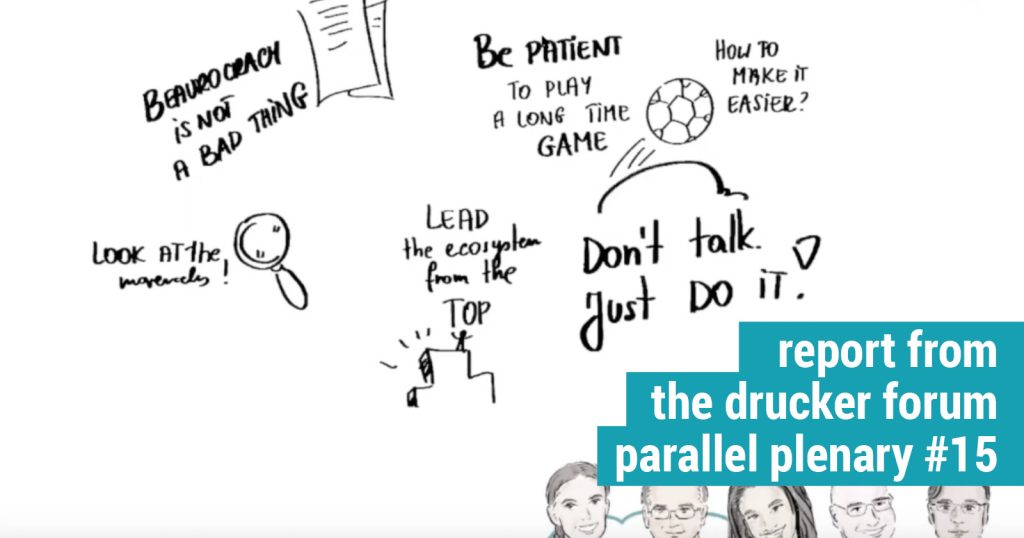
Moderator
Rosanna Sibora, Director, IT Innovation, Universal Music Entertainment GmbH
Speakers
Donald Allan Jr., President & Chief Financial Officer, Stanley Black & Deckerer
Simone Ahuja, Author and Founder Blood Orange, a global innovation strategy firm
Robert I. Sutton ,Professor of Management Science, Stanford University of Engineering
Martin Reeves, Chairman BCG Henderson Institute
Not for romantics – #15 Turning Large Enterprises into Hotbeds of Innovation
“It is an ongoing challenge that never ends”, Donald Allan, CFO of Stanley Black & Decker, replied to Rosanna Sibora’s question about what the biggest challenges are for large companies on the road to harnessing innovation.
10 years ago, Stanley Black & Decker focused only on incremental innovation with a “frozen middle”. “We spent a lot of time helping middle management feel empowered and ‘unfrozen’”. Then they started building an innovation ecosystem consisting of several elements: incremental innovations, a group of employees working on disruptive innovations, another one working on disruptive innovations, called “Stanley X”, and a venture group looking out on start-ups.
“That whole evolution has been driven from the top of the company,” explained Donald. It was 3 people who designed and implemented the new innovation system and made it successful.
Drucker Forum 2021
Not for romantics
This panel was not for innovation romantics, with participatory ideas, pure agile principles, or start-up dreams in mind. “The assumption that big companies don’t innovate is suspect,” was the starting point of Bob Sutton from Stanford University. Basically, as a big company wanting to be innovative, you must avoid 2 things: paying people for just talking about innovations and having the idea, everyone has to be involved in innovation. Martin Reeves of the BCG Henderson Institute added that the success of big companies in being innovative has to do with the observed shift from a focus on efficiency to a focus on the rate of learning.
Only Simone Ahuja, founder of Blood Orange, put forward a not so rosy picture of innovative big companies. She thinks that “there is a long way from the idea to execution to innovation”. We do have a lot of “innovation theatre because it is all about change”.
Of course, in this specific panel there was a lot of talk about the examplars of Apple, Google, Microsoft, Disneyland and similar American success stories. “You have to generate a lot of ideas and then kill almost all of them again.” “You need 2 kinds of collaboration, the nice one is the agile get-together. The nasty one is authoritarian decision-making.” Just look at the highly successful Steve Jobs who had set up a permanent authoritarian innovation system at Apple.
The most important factor in this respect, according to Bob, is logical consistency within the company. This means that everyone knows what the game is about, works within the same structure, under the same rules, and, of course, with the right mindset.
The power of imagination is certainly a key factor for innovation. What prevents a company from unleashing this power? According to Martin, there are four things: complacency, the continuation of past successes, a lack of curiosity and introversion. That’s why it’s so important to make sure people stay externally oriented, focused on the outside world.
But how can you drive curiosity? Openness, diversity, reflection on past and future, empiricism – trying things out and seeing what happens -, dissemination of ideas, codification to scale ideas, humbleness. Martin listed these factors as if shot from a gun. They are shaped by the company’s culture and the precedents set by its leadership.
“The magic happens during the collaboration process, when we build on ideas of others. So, is it possible for organizations to harness imagination collectively?”, asked our moderator Rosanna. Or are imaginations unmanageable, in the sense that we need these genius leaders like Steve Jobs to drive the process? According to his cognitive science research Martin believes that to some degree the process of collective imagination is manageable if you do six things right: openness to surprises, discipline[1], experimentation, dissemination of ideas, codification in scaling ideas and the ability to check your own success.
Simone then was asked about another aspect: Intrapreneurship. She referred to the power of diversity and that everyone can have good ideas. When it comes to innovation, intrapreneurship “moves the needle”. But for that, you have to overcome inconsistencies. Only when you teach people communication and problem-solving skills will they say yes to change.
Take-aways?
It was a panel discussion about the realities in the corporate world. Nothing was glossed over. Sobering for all those who believe in one or the other idea of new forms of work that generate more creativity and innovation.
The one panelist who comes from real leadership practice showed what is always behind successful innovation: hard work. The others, the thinkers, professors, and consultants, joined In sober analysis of the underlying drivers and interconnections. This culminated in the final round query of take-aways in Bob‘s response: “Inspired by Don, bureaucracy is not a bad word.”
Only Simone countered a bit with her take-away stated at the end, “patience in the long run”.
[1] I did not exactly catch what Martin has said at this point
About the Author: Hans Stoisser is an entrepreneur and management consultant with long-standing experiences in various African countries; and has attended all of the previous Global Drucker Forum events.
This article is one in the “shape the debate” series relating to the 13th Global Peter Drucker Forum, under the theme “The Human Imperative” on November 10 + 17 (digital) and 18 + 19 (in person), 2021.
#DruckerForum

